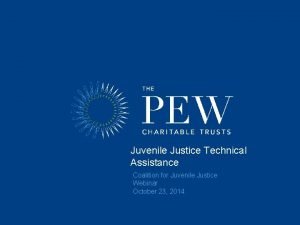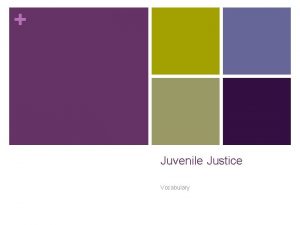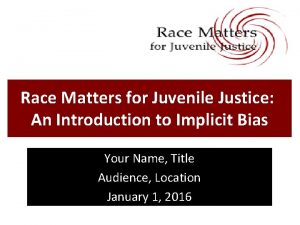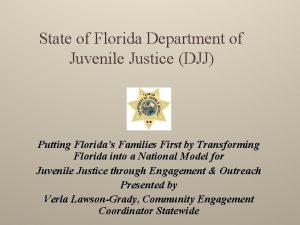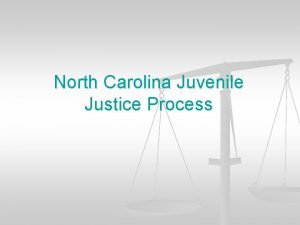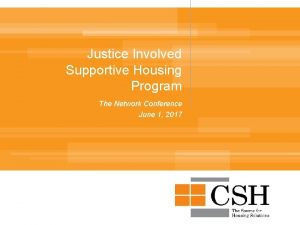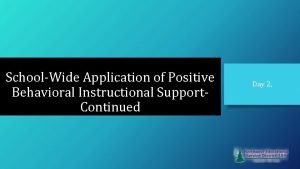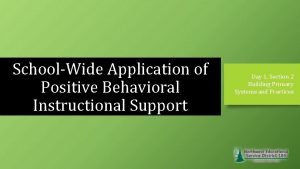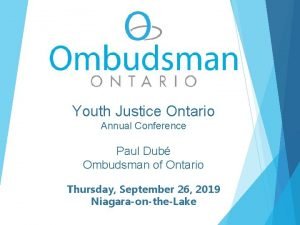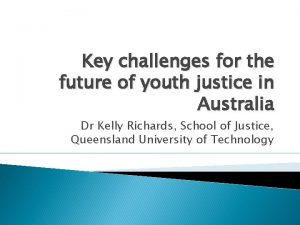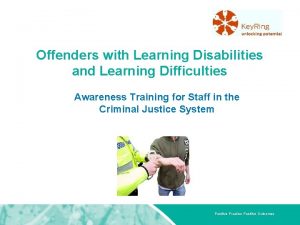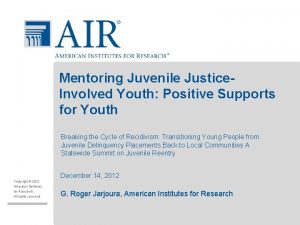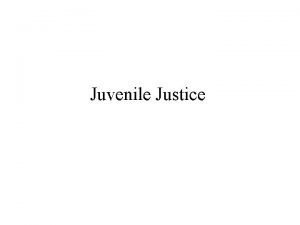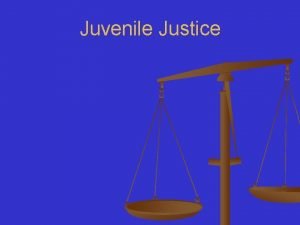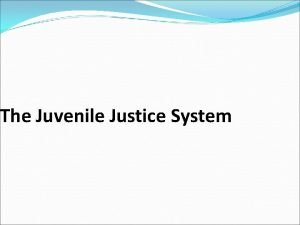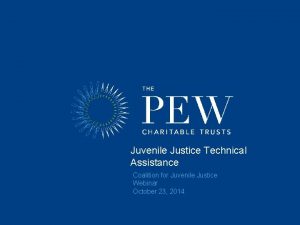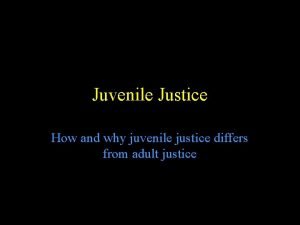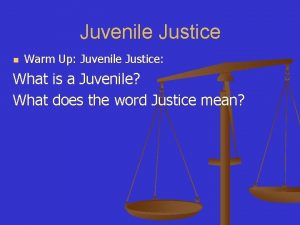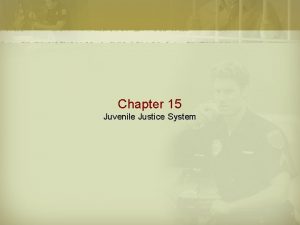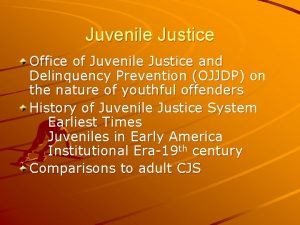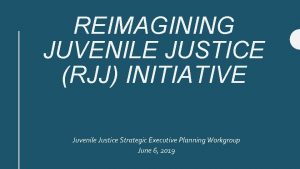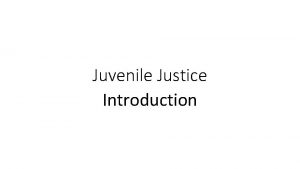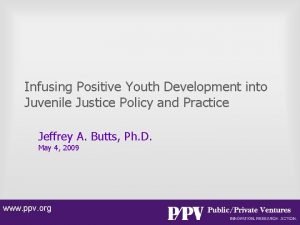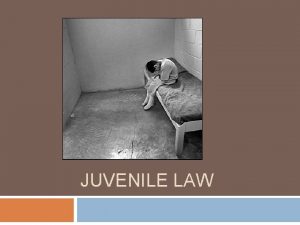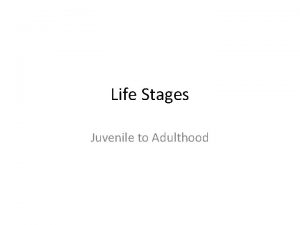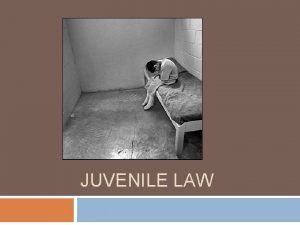Mentoring Juvenile Justice Involved Youth Positive Supports for



































































- Slides: 67

Mentoring Juvenile Justice. Involved Youth: Positive Supports for Youth Breaking the Cycle of Recidivism: Transitioning Young People from Juvenile Delinquency Placements Back to Local Communities A Statewide Summit on Juvenile Reentry December 14, 2012 Copyright © 2012 American Institutes for Research. All rights reserved. G. Roger Jarjoura, American Institutes for Research

Some Assumptions • Not necessarily new information • Mentoring is about § Investing in relationship § Choices § Modeling behavior • Teamwork is critical for success • It is difficult to accurately predict when it is time to give up on any particular youth • Who a person “is” is not necessarily demonstrated by their behavior • Mentoring is about giving, but we can’t take it personally 2

Definition • Reentry refers to the return of the offender from a placement outside of the home community back to the home community. 3

Note: • Reentry or “Going Home” is what most juvenile offenders think about from the time they enter confinement until the moment they leave. 4

The Philosophy of Juvenile Reentry • Should include: § Exit upon Entry § Principles of balanced and restorative justice 5

Exit upon Entry • A model for Reentry and Transition Services • From the moment youths enter the facility, staff are implementing programs, services, and activities that support the youth’s successful exit from the facility and reentry into the community • Beginning the process immediately is an important element of reentry 6

Balanced and Restorative Justice philosophy • Goals include: § Community Protection § Accountability factors including restoring the community and victims for the harm done to them § Core Competency Development allowing offenders to leave the juvenile justice system better prepared to successfully reenter the community than when they arrived 7

NJDA’s vision statement reads: • The most efficient way to return a juvenile to a healthy, law abiding lifestyle is through healthy relationships with healthy adults in healthy environments. 8

Consider the following: • “Every reentry implies removal. As the degree of removal increases, the efforts required for successful reentry also increase. ” • The act of removing a juvenile from home, school, neighborhood, faith community, and friends can easily be negative and disruptive despite its intended positive outcomes. 9

Reentry challenges? • Community may not want them next door • Government restrictions on job and housing • Parole/probation officers have overwhelming caseloads • Ex-offenders unaware of services that may be available to meet their needs • Little coordination between service providers 10

Putting this altogether: • Few resources • Few skills • Inadequate monitoring • Leads to turning back to crime 11

Success is Enhanced • When treatment spans the period of incarceration and the release period (Continuity of care) • Vocational and job-training/preparation • Raising educational attainment • Drug treatment programs inside and out • Comprehensive case management • Transition Teams 12

TRANSITION CONFINEMENT NORMALIZATION Institution Commitment Community Reentry Successful Termination 1. Pre-release Planning 3. Reintegration Activities 2. Structured Re-entry

Phase 1: Making the Plan – Protect and Prepare • Making the Plan – Protect and Prepare refers to institution based programs designed to prepare offenders to reenter society. § Effective Assessment. The better the match between offender needs and programs and services, the greater the likelihood of success. § Balanced assessments include a risk assessment (identification of those issues that increase the likelihood of recidivism), protective factor assessment (identification of those factors that work to prevent recidivism), and strengths-based assessment (identification of a place to start). 14

Phase 2: Transitioning Home – Control and Restore • People and agencies from the community are coming into the facilities to work with youth before they leave. • There is a plan developed prior to release. 15

Phase 3: Staying Home – Sustain and Support • Sustaining momentum is a difficult task. • The responsibility and productivity phase follows the successful completion of the reintegration plan. • Community-based, long-term support targets resources for the purpose of establishing networks of support for the offenders that will be sustained in the absence of juvenile justice supervision. 16

Why Mentoring? • Adult guidance, support • Problem solving • Transfer of support from confinement to chaos of daily life 17

Some Specific Protective Factors • active involvement in extracurricular events • involvement in “required helpfulness” • support outside the home environment • interest in school and learning • relationships with other adults that are based on strong interpersonal skills and professional competence 18

How it Works • significant adult relationships and positive use of time lead to: • encouragement, high expectations, support system, recognition, and accomplishment, all of which leads to: • self-efficacy, goals-oriented, personal responsibility, optimism, internal expectations, and coping ability • the end result is resiliency, or success 19

Why Do Some Avoid Delinquency? • They do not have the opportunity (includes effective supervision) • The stakes are too high • That is not who they are • Some do not get caught! 20

Don’t Underestimate the Effect of Staying Busy • Positive activities • Prosocial peer networks • Education • But work is not always a good thing 21

Mentoring • From the research we know that mentoring is an effective intervention for: § Predelinquents § Delinquents § Juvenile offenders returning from incarceration • When it is done correctly, it is a “Best Practice. ” 22

What It Costs • Mentoring programs do not require a great deal of financial resources • On the other hand, when there is not a sufficient infrastructure to recruit, screen, train, and supervise the mentors, the mentoring is not likely to make a difference and may even be harmful for the youths. 23

What is Mentoring? • Supportive relationships with adults other than parents • Adult role models—the evidence points to better results for mentors over 21, with maturity and life experiences being critical factors • Caring adults—the motivation of the mentor is significant • Volunteers as mentors 24

Principle 1: Start with a big vision for the ultimate outcome—Productively engaged adult citizens 25

Don’t aim too low • Why are the kids we serve different from our own children? 26

Life Prep • What is adult world like? • What is the modern workplace all about? • What skills and knowledge are required for competence on the job? • It’s about fostering work-life readiness 27

Employers Would Like… • Communication skills—verbal and written • Honesty/integrity • Teamwork skills • Interpersonal skills • Strong work ethic • How can you have influence here? 28

Principle 2: Understand adolescent development and how juvenile reentry programs fit into the process 29

This Means Focusing on Each: • • Competency Life skills Positive development—Strengths-based Interpersonal skills (emotional intelligence) • Accountability • Decision making and problem solving 30

Normal Adolescent Development • • Impulsivity declines with age Sensation-seeking declines with age Future orientation increases with age As people age, they spend more time thinking before they act • Resistance to peer pressure increases with age 31 Based on scholarship of Griffin (2010), Northwestern University Law School

Consider: 32 From: Gardner and Steinberg (2005) “Peer Influence on Risk Taking, Risk Preference, and Risky Decision Making in Adolescence and Adulthood: An Experimental Study” Developmental Psychology

When Kids Experience Trauma during Childhood • They experience delays in developmental milestones • Have higher rates of learning disabilities • Experience difficulties with problem solving • Are more impulsive and engage in problem behaviors at higher rates • Struggle with interpersonal relationships and emotional intelligence 33

Balanced and Restorative Justice philosophy • Goals include: § Community Protection § Accountability factors including restoring the community and victims for the harm done to them § Core Competency Development allowing offenders to leave the juvenile justice system better prepared to successfully reenter the community than when they arrived 34

Mentoring Programs • Can inspire and guide people to pursue successful and productive futures, reaching their potential through positive relationships and utilization of community resources 35

Mentoring Can be Transformative • Here we are looking for mentors to do more than simply “hang out” with the young people • If mentors are properly prepared, they can influence the youth in meaningful and significant ways • We may not see immediate short-term changes, but long-term personal growth has a lot to do with the adults in their lives 36

Mentors Can Build Skills in… • Decision Making • Problem Solving • Accessing Resources • Healthy Relationships 37

Principle 3: It is all about Relationships and Contexts (and Time) 38

Choices about spending leisure time Low selfesteem Dysfunctional Family Consider the risk factors that contribute to the likelihood that the youths are going to be delinquent Low academic achievement Challenges around work Negative Peers Disadvantaged neighborhoods 39 Problems in School Drugs and Alcohol

The relationship they have with their free time The relationship they have with themselves The relationship they have with money The relationship the kids have with their families These can all be reframed in terms of dysfunctional relationships The relationship they have with learning the community 40 The relationship they have with drugs and alcohol The relationship they have with their teachers The relationship they have with work The relationship they have with their peers

Context is Typically Underestimated • NJDA’s vision statement reads: § The most efficient way to return a juvenile to a healthy, law abiding lifestyle is through healthy relationships with healthy adults in healthy environments. 41

Time: A Numbers Game • Think about the number of hours there are in a week • How much of that time will a youth spend in the “company” of a mentor? • How is the remaining time being spent? 42

Reality: Mentoring is Hard • only about one third of all matches turn into significant relationships • it is not easy to “make a difference” § sometimes the needs of the youth are profound § mentors are just one influence amid many on the lives of the youngsters 43

Principle 4: Find mentor programs that are Right 44

Critical components of effective programs: • Recruitment strategy • Effective screening process • Effective orientation and ongoing training for mentors • Support systems for mentors • Structured activities for the mentor and mentee are helpful for building the relationship 45

Critical components of effective programs: • The more frequent the contact the better • Support and involvement of the parents helps improve outcomes • Resources for mentors and families when needs are identified • Ongoing monitoring of program implementation 46

Effective Programs • incorporate practices that support mentor retention so the relationship does not terminate early if the mentor loses motivation or becomes overwhelmed. • maintaining the mentor’s motivation through training, supervision, ongoing support, accountability, and recognition of their efforts fosters retention 47

First Things First… • a good screening process can assess whether someone has the qualities and qualifications suitable for a relationship with a system-involved youth • also provides potential mentors with an accurate picture of the types of issues and problems they can expect to encounter working with court-involved youth 48

Screening Matters • An important part of retaining mentors is making sure the right people are brought on board from the start 49

Team Mentoring § A strategy that builds support and accountability for the mentors § A way to minimize the likelihood that mentors or mentees fall through the cracks when the mentor-mentee match doesn’t work out § A way to build in natural selection to the match process, increasing the likelihood of a successful match 50

Some Common Challenges • • • 51 youth doesn’t return phone calls youth doesn’t show up for meetings youth is rude and hostile towards the mentor youth doesn’t talk to mentor youth is sexually promiscuous youth breaks the law youth shows up high or intoxicated mentor doesn’t know what to do with youth mentor feels overwhelmed by the youth’s problems mentor doesn’t agree with the youth’s values mentor is frustrated by lack of impact on youth

Effective Programs • focus their efforts on tapping into the internal motivation of mentors by § helping them become more competent § assessing the relevance of their work § building their sense of belonging to a worthwhile effort 52

Consider the Following Scenario • A mentor and mentee are hanging out. The mentee says: “I didn’t feel like going to work yesterday, so I called in and said I was sick. ” • The “right” mentor would respond how? Pick one of the following responses: 53

The Mentor would Respond: a) I understand. If I was only making $7. 50 an hour, I would call in sick too if I didn’t feel like working. b) That reminds me of a time that I called in sick so that I could go to the beach with my college friends. It was a nice day and we picked up some beer along the way and had a great time! 54

OR… c) You are kidding. That was very irresponsible of you! You will not hold onto that job for very long playing those kinds of games. d) What do you think that was like for your boss and the rest of the staff? Have you been at work when someone else called in sick? What was that like? If your boss gets used to not having you around, how do you think this might affect you? Is there some other way you could have handled not wanting to go to work? 55

Is it Important that Mentors are Volunteers? • while there are some models of intensive mentoring (over 10 hours per week) for which the mentors are paid an hourly wage, most youths do not require this level of support • when we ask mentors to take on therapeutic roles, the mentoring piece may be neglected • offering compensation for a mentor’s time complicates the screening and recruitment processes—you want mentors who want to make a difference in the lives of a youth, not those just looking for additional forms of income 56

How do we shape the mentoring experiences? • The best evidence we have is that one-on -one mentoring is the most effective--this does not mean, however, that one mentor cannot successfully work with more than one youth at a time, as long as the youths receive individual personal attention • The evidence also leans in favor of samesex matches between mentor and mentee 57

How do we shape the mentoring experiences? • Mentors should be asked to make a commitment for a specific length of time —it is common to require one year 58

Inoculation of Your Mentors • If we tell the new volunteers they are likely to want to quit for certain reasons (that we walk them through), it decreases the probability they will actually quit when faced with the challenges they were warned about 59

Things like: • System-involved youth have been let down by adults many times. They are likely to keep the mentors at arms length for some period of time until the mentor “passes the test. ” • This is a transient population and the youths may change residences, have their phone numbers disconnected or changed, or may spend very little time at home making it difficult to catch them. 60

And… �Many adults have a hard time with the progress that these youth demonstrate—it is often very slow and can involve several missteps and relapses along the way. �The strongest mentor-mentee relationships grow out of crises and conflicts—yet mentors will be inclined to avoid the youth while they are dealing with conflict and crises. �There are many potentially upsetting elements to working with this population. Mentors need to learn to look for support and not look for the way out of the program. 61

Expectations • In any crisis—big or small—mentors need to know not only who to call and their phone number, but also that they are expected to call • Without accountability, time together can easily slip into simply “hanging out” • Key issues: § Maintaining contact with mentees § What happens when kids get into trouble or are moved without notice? § Make sure mentors have comprehensive contact information and plans to be in touch! 62

More on shaping the mentoring experience • Mentoring is going to be more effective if it involves regular (at least weekly) contact over an extended period of time. • The youths anticipate that adults are not in it for the long term and when they learn otherwise, they take the kinds of risks in the relationship with their mentors that lead to real personal growth and development. 63

Mentor Accountability • How do you plan to hold mentors accountable? • What messages do they hear from you? § Are those messages empowering or discouraging? 64

Additional Considerations • In programs working with delinquents, it is helpful initially at least to be able to leverage the participation of the youths with the mentors. • At the same time, it is important that the mentor have some input in case dispositions—if the mentor wants to advocate on behalf of the youth, it can strengthen the relationship if it appears that the mentor’s input is at least considered. 65

Principle 5: Don’t Underestimate the Power of a Single Moment 66

This is about things like… • Are you “impeccable” and thoughtful with your words? • Are you more likely to ask questions or to lecture? • Do youth believe that you LISTEN to them? Are they correct? • What do youth learn by watching your behavior? • Would you say you are “Mentor-like”? 67
 Georgia juvenile justice system
Georgia juvenile justice system Coalition for juvenile justice
Coalition for juvenile justice Juvenile delinquency vocabulary words
Juvenile delinquency vocabulary words Juvenile justice act 2000
Juvenile justice act 2000 Race matters for juvenile justice
Race matters for juvenile justice Minnesota juvenile justice system
Minnesota juvenile justice system State of florida department of juvenile justice
State of florida department of juvenile justice North carolina juvenile justice process
North carolina juvenile justice process Chapter 11 basic concepts street law
Chapter 11 basic concepts street law Juvenile justice alternative education program
Juvenile justice alternative education program Juvenile justice system in georgia
Juvenile justice system in georgia Ra no 9344
Ra no 9344 Justice involved supportive housing
Justice involved supportive housing Period of the bloody placards
Period of the bloody placards Positive behavioral interventions and supports
Positive behavioral interventions and supports Positive behavioral interventions and supports
Positive behavioral interventions and supports Youth justice ontario
Youth justice ontario Youth justice quotes
Youth justice quotes Positive characteristics of youth
Positive characteristics of youth Staphylococcus shape
Staphylococcus shape Negative number rules
Negative number rules Positive practice positive outcomes
Positive practice positive outcomes Epiteltyper
Epiteltyper Trög för kemist
Trög för kemist Argument för teckenspråk som minoritetsspråk
Argument för teckenspråk som minoritetsspråk Humanitr
Humanitr Multiplikation med decimaltal uppgifter
Multiplikation med decimaltal uppgifter Delegerande ledarstil
Delegerande ledarstil Toppslätskivling dos
Toppslätskivling dos Ekologiskt fotavtryck
Ekologiskt fotavtryck Redogör för vad psykologi är
Redogör för vad psykologi är Lek med geometriska former
Lek med geometriska former Bris för vuxna
Bris för vuxna Bra mat för unga idrottare
Bra mat för unga idrottare Etik och ledarskap etisk kod för chefer
Etik och ledarskap etisk kod för chefer Publik sektor
Publik sektor Personlig tidbok
Personlig tidbok Datorkunskap för nybörjare
Datorkunskap för nybörjare Fredsgudinna
Fredsgudinna Kontinuitetshantering
Kontinuitetshantering Rita perspektiv
Rita perspektiv Ministerstyre för och nackdelar
Ministerstyre för och nackdelar Vem räknas som jude
Vem räknas som jude Bästa kameran för astrofoto
Bästa kameran för astrofoto Tillitsbaserad ledning
Tillitsbaserad ledning Nyckelkompetenser för livslångt lärande
Nyckelkompetenser för livslångt lärande Romarriket tidslinje
Romarriket tidslinje Bunden eller fri form
Bunden eller fri form Modell för handledningsprocess
Modell för handledningsprocess Varför kallas perioden 1918-1939 för mellankrigstiden
Varför kallas perioden 1918-1939 för mellankrigstiden Borstål, egenskaper
Borstål, egenskaper Orubbliga rättigheter
Orubbliga rättigheter Verktyg för automatisering av utbetalningar
Verktyg för automatisering av utbetalningar Vishnuiter
Vishnuiter Jätte råtta
Jätte råtta Kolposkopi, px
Kolposkopi, px Bo bergman jag fryser om dina händer
Bo bergman jag fryser om dina händer Tack för att ni lyssnade bild
Tack för att ni lyssnade bild Strategi för svensk viltförvaltning
Strategi för svensk viltförvaltning Novell typiska drag
Novell typiska drag Vad är verksamhetsanalys
Vad är verksamhetsanalys Tack för att ni har lyssnat
Tack för att ni har lyssnat Treserva lathund
Treserva lathund Cks
Cks Läkarutlåtande för livränta
Läkarutlåtande för livränta Påbyggnader för flakfordon
Påbyggnader för flakfordon Inköpsprocessen steg för steg
Inköpsprocessen steg för steg Sura för anatom
Sura för anatom

